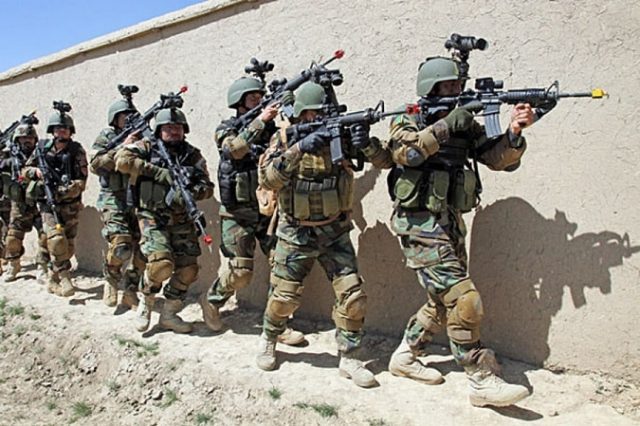Saqib Manzoor |
Hundreds of seasoned and battle-hardened troops of Army have been deployed in Afghanistan to offer new types of training to Afghan security forces. The troops in the Security Force Assistance Brigade, or SFAB, have had multiple deployments in Afghanistan and have been specially trained themselves. Many speak some Pashto or Dari. The Pentagon hopes that these troops will allow the Afghan security forces to turn the tide of war.
“They are coming here because they are passionate about the mission,” Navy Captain Tom Gresback, a spokesman for NATO’s Resolute Support said.
Sooner or later, the US will pull out of Afghanistan. The war has not been popular in the eyes of the American public for a number of years.
The Afghan National Security Force or ANSF consists of three sub-units: the Afghan National Army or ANA, the Afghan National Police or ANP and Afghan National Army Air Corps or ANAAC. In addition to that, the Afghan Local Police is a US-UK sponsored local policing force. The Obama administration had mulled over increasing troop numbers in Afghan Army to 400,000. The FY2016 budget request for , the total number of Afghan National Security Forces supported a troop strength of 352,000, with the Afghan National Army comprising of up to 195,000 troops. For comparison, the Pakistan Army has nearly 600,000 troops. The total number of troops in the Afghan Security Forces, however, remains unclear since there have been as many as 30,000 ghost soldiers on the US payroll.
Read more: Afghanistan: The growing ethnic tension has its roots in history
Few would question the reason behind sending the brigade. Afghan security forces have been suffering from all sorts of problems such as low morale and high casualty rates. Being beset with corruption and desertions does not help either. Many soldiers have gone AWOL during training. At one point, the security forces were blaming each other for their failures. There have also been instances where Afghan policemen have killed fellow soldiers. Furthermore, security forces in Afghanistan have been known to sell weapons to the Taliban.
Various approaches have been tried to improve the performance of Afghan security forces but bore no fruit. A report by the Special Inspector General for Afghanistan Reconstruction showed that the US has bungled nearly $70 billion in training Afghan security forces. US efforts in training Afghan security forces have been hampered by governance failure, poor instruction and shoddy oversight, a report by a military watchdog revealed. On top of that, more than half the troops in the Afghan Army are illiterate. This creates an additional barrier for imparting effective training. Not only do American trainers have to be able to speak and understand Pushto and Dari, they also have to teach Afghan recruits to read and write Pushto and Dari. Consequently, literacy training has become mandatory as part of the overall training of Afghan troops.
Read more: Russia adopting US tactics from Afghanistan in Syria?
Another reason for the failure of the US in training Afghan troops is a chronic lack of continuity in American policy towards Afghanistan. When George W. Bush launched the invasion of Afghanistan, he famously said that the US should not be nation building in Afghanistan. Soon, however, he changed his mind. His successor got elected on a campaign promise of bringing the troops home and not participating in unnecessary wars. Obama reduced the number of troops to about 10,000 for assisting and advising Afghan troops from about 140,000 at the height of the invasion. Obama had initially aimed at a complete withdrawal of troops at the end 2016 but stopped short at a drawdown of troops, considering the fact the Afghan security forces were not yet ready to handle security in Afghanistan on their own. Trump, on the other hand, decided that the US is not going to be in the business of nation building again, as he unveiled his strategy for Afghanistan in August, 2017. This lack of permanency by American policymakers towards Afghanistan does not bode well for the landlocked nation, which is now entering its 17th year in the war.
In addition to that, the Afghan Local Police is a US-UK sponsored local policing force. The Obama administration had mulled over increasing troop numbers in Afghan Army to 400,000.
The total budget for Afghan National Security Forces in FY 2016 was $5.4 billion, out of which the United States funded approximately $4.1 billion. As Georgetown University Professors and former Rand Corporation expert Dr. Christine Fair has pointed out, the Afghan government can’t pay for itself. This is perhaps the biggest hurdle in training the Afghan National Security Forces. Sooner or later, the US will pull out of Afghanistan. The war has not been popular in the eyes of the American public for a number of years. Polls by Gallup revealed that since 2011, more Americans oppose the war in Afghanistan than who support it. A time may come when politicians can’t defend funding the Afghan war at home anymore.
Read more: India-bound gas pipeline breaks ground on Afghan section
Perhaps, this is the reason why stop-gap measures such as sending in a brigade of battle-hardened and experienced troops to train the Afghan troops in a new way are adopted, in the vain hope that Afghan National Security Forces would be able to pick up the mantle and carry out military operations on their own. It remains doubtful whether this ‘new type’ of training will solve long-standing problems that Afghan National Security Forces have been suffering from.













